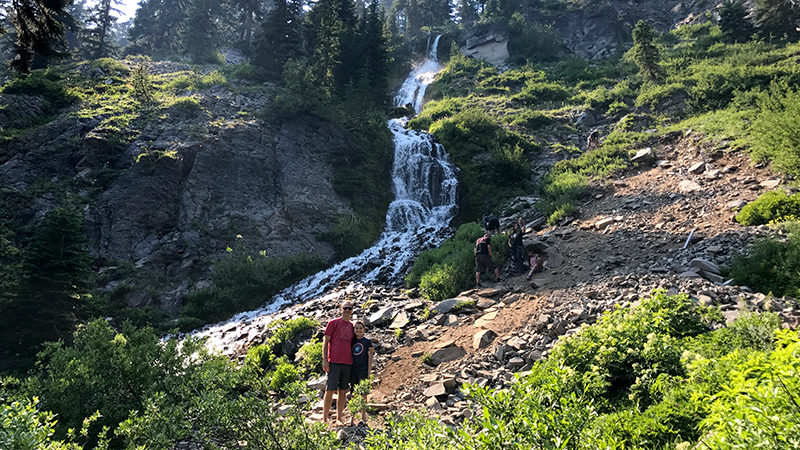
It was late afternoon and our day at Crater Lake National Park was coming to a close. We had stopped at all of the major scenic viewpoints overlooking deep, blue Crater Lake, enjoyed a picnic lunch with incredible views, hiked to an amazing waterfall, and saw intriguing pinnacle formations. But we couldn’t call it a day just yet…
I still wanted to explore the Castle Crest Wildflower Trail, walk the Godfrey Glen Trail, and checkout a waterfall that plunges down a cliff right off the side of the road.
Vidae Falls
Because it is accessible from the side of the road, Vidae Falls is the most popular and well-known waterfall in Crater Lake National Park.
Vidae Falls is a part of Vidae Creek, which flows from small, consistent spring near the Crater Lake caldera rim 600 feet above the lake’s surface. The magnificent waterfall tumbles down a rocky, forested, glacier-carved cliff, dropping 100 feet before cascading over a talus slope, into a small pool, and disappearing beneath Crater Rim Drive.
A wide pull out provides parking, but it’s not very big and can fill up fast. When the park is full, you may have to park in the nearby picnic area parking lot and walk over. Late in the afternoon, we had no problem parking and hopped out of our car to get a closer look at the waterfall, the beautiful pool at the bottom, and the beautiful green, rocky hillside. For those who want another hiking opportunity, a short access road at the base of the falls leads to a picnic area and the Crater Peak trailhead.
In summer, Vidae Falls is surrounded by forest, grasses, and wildflowers and is really quite beautiful. In winter, it can be covered in snow or a lattice of ice, but remains accessible with snowshoes or cross-country skis.
Know Before You Go
- Crater Lake National Park, Oregon’s only national park, does not have a physical street address, so it can be hard to locate us using GPS. We made the historic Crater Lake Lodge our first stop, which is located at 565 Rim Drive, Klamath Falls, Oregon 97604.
- Vidae Falls is located 3.0 miles east of the Crater Lake National Park Headquarters on East Rim Drive. There is a large turn-out on the side of the road for parking but if it is full, you can park in the picnic area across the road.
- At 1,943 feet deep, Crater Lake is the deepest lake in the United States and the principal feature of Crater Lake National Park.
- The 33 mile Rim Drive that travels around Crater Lake’s caldera features spectacular views of the lake and interpretive signage at all of the main vista points.
- Good for seven days, admissions fees are $30.00/vehicle, $25.00/motorcycle in the summer and $15.00/motorcycle in the winter, and $15.00/pedestrian or bicycle.
- The national park is open year-round, 24 hours a day but many of the park’s roads, trails, and facilities are closed seasonally.
- During periods of rain and snow, Crater Lake is often hidden by clouds — it is completely invisible about 50% of the time in the winter!
- Summers at Crater Lake are short but typically sunny. July, August, and September are your best bets for warm, dry weather. However, it can snow any day of the year.
- The park’s North Entrance is closed for about seven months each year. It closes at the first snowfall or on November 1, whichever comes first and reopens in early to mid-summer. The park’s South Entrance and West Entrance are open year-round. We visited the park in late July and the roads had only been open for a week!
- Dogs on-leash are permitted only in developed park areas and in Mazama Village and Lost Creek Campground. Dogs are not permitted on any trails or in undeveloped areas.


